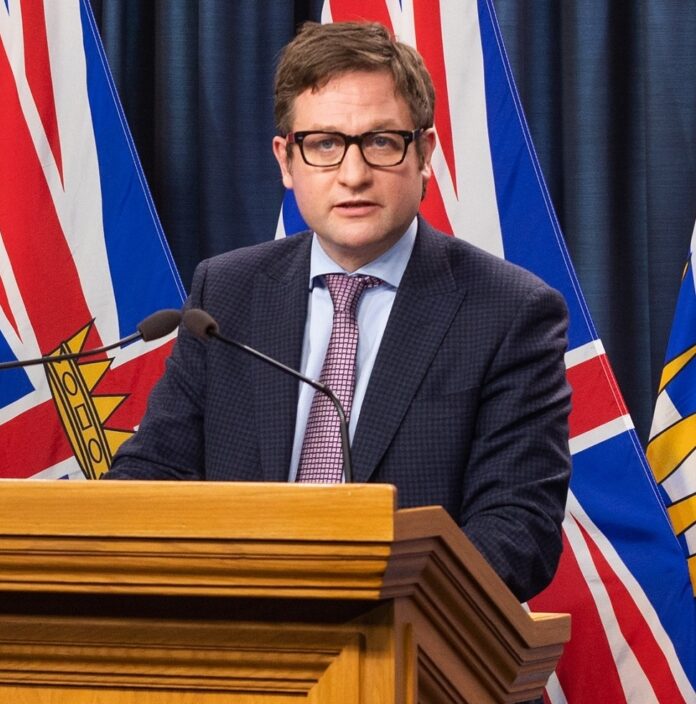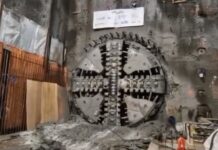– The new Pattullo Bridge is now expected to open in fall 2025
– The Broadway Subway is now expected to go into service in fall 2027
DRIVERS and people who take transit in the Lower Mainland are closer to faster and more convenient travel as both the Broadway Subway Project and the Pattullo Bridge Replacement Project have reached significant milestones, the Province said on Friday.
Tunnel boring operations have finished, marking the completion of the most technically complex and challenging part of the new subway construction.
Meanwhile, construction of the main tower for the new bridge to replace the existing Pattullo, connecting Surrey and New Westminster, is complete. This is the tallest bridge tower in British Columbia.
“Despite facing significant global challenges, we’ve seen tremendous progress on both of these projects,” said Rob Fleming, Minister of Transportation and Infrastructure. “These projects will move people and goods more quickly and safely around the Lower Mainland.”
The Pattullo Bridge Replacement Project started at the beginning of the pandemic in February 2020. Since then, it has faced significant challenges, including inflationary pressures and global supply issues related to the delivery of specialized components from around the world. In addition, the bridge tower construction took longer than expected. As a result, the new bridge is expected to open in fall 2025.
The new bridge will provide people with better connections and modern, wider lanes separated by a centre median barrier and dedicated walking and cycling lanes. Once complete, the bridge will provide a safer commute for people driving, cycling, or walking, and a more efficient connection for goods movement between Canada and the United States.
Design and construction activities on the Broadway Subway Project, which also began during the pandemic in September 2020, have taken longer than originally expected, including work to relocate major utilities and install traffic decks, while keeping traffic moving along Broadway. Tunnelling, which included boring under the Canada Line, and station excavation also took longer. This was in part due to a five-week concrete strike in 2022 that delayed construction of the launch pad for the tunnel-boring machines. Despite making significant progress so far, the new line is expected to go into service in fall 2027.
On projects of this size, delays have the potential to affect other construction activities. While mitigation efforts were made to recover both project schedules, it wasn’t always possible.
Once complete, the Broadway Subway will transform how people get around. It will mean faster travel, better access, and fewer cars on the road. The commute from VCC-Clark to Arbutus Station will take 11 minutes, saving the average transit commuter almost 30 minutes a day and will relieve congestion along Broadway.
Learn More:
To view photos and videos of the Broadway Subway project and the Pattullo Bridge Replacement Project:
https://spaces.hightail.com/
To learn more about the Broadway Subway project: https://www.broadwaysubway.ca/
To learn more about the Pattullo Bridge replacement project: https://www.
BACKGROUNDER 1
Pattullo Bridge replacement project
The new Patullo Bridge will be a massive and complex structure, including the tallest bridge tower in British Columbia. There are many factors that must be carefully, methodically and safely managed throughout construction.
The new bridge is being built with specialized components supplied from all over the world, including from China, France, Italy, India, Indonesia and Spain. Following the pandemic, the disruption in the supply chain affected the fabrication of bridge components. In particular, structural steel shipments from China were delayed, affecting project construction.
Construction has also taken longer than expected due to the complexity of the project and the unique and sensitive environment in which it is being built. The project required careful planning to minimize impacts to the Fraser River and surrounding environment, and to protect historic and culturally significant sites. Building in a constrained setting while minimizing impacts to road, rail and marine users in a busy corridor also adds to the complexity of the work.
Despite these challenges, progress has been made. All necessary structural materials for the bridge have been secured, and the 167-metre-tall bridge tower is complete.
Cable stay installation and bridge deck construction are underway, and crews are installing steel girders that will form the bridge deck on the north and south approaches.
The aging Royal Avenue Overpass in New Westminster has been upgraded to current seismic standards and numerous underground utilities, including electrical, sewers and drainage have been installed or relocated.
Upcoming work on the project includes:
* building the 530-metre cable-supported bridge deck and installing 80 stay cables outward from the bridge tower;
* completing the north and south bridge approaches;
* completing the East Columbia on and off-ramps in New Westminster; and the Highway 17 off-ramp and Highway 17/Old Yale Road Overpass in Surrey; and
* completing final utility relocations, multi-use path construction, street restoration and landscaping.
BACKGROUNDER 2
Broadway Subway project
The Broadway Subway is a complex infrastructure project with multiple work sites in a dense urban environment. Government has committed to maintaining mobility for all modes of transportation during construction, including transit service on one of North America’s busiest bus routes, as well as access to thousands of residences and businesses through the entirety of construction. Tunnel boring was particularly complicated adjacent to existing infrastructure, such as the Canada Line and some major utilities that service the region.
Work began during the COVID-19 pandemic, which slowed the pace of organizing resources, equipment, materials, staff and early work to relocate utilities and install traffic decks, which required complex traffic management to keep traffic moving along Broadway. A five-week labour dispute in the concrete industry delayed construction of the launch pad for tunnel-boring machines.
Many aspects of the project are integrated and need to be completed in sequence. When one activity takes longer to complete, that affects the rest of the work, including tunnelling and station construction.
At the same time, noisy work at night is restricted in consideration of nearby residents.
Progress to date includes:
* installation of five traffic decks and five pedestrian walkways along Broadway to keep people moving during construction;
* relocation or protection in place of multiple utilities at all six station sites;
* completion of tunnel boring from Great Northern Way-Emily Carr Station to Arbutus Station;
* completion of the 700-metre-long elevated guideway structure connected to the existing Millennium Line at VCC-Clark Station;
* excavation of five out of the six underground stations is finished, and the concrete bases of the stations have been built; and
* construction of the concourse levels of five out of six stations is well underway, and work on the roof has begun at Great Northern Way-Emily Carr Station.
Next, crews will:
* finish removing the tunnel-boring machines and their conveyor systems from the tunnels and stations;
* increase the pace of station work once unobstructed by tunnelling equipment;
* complete station excavation at Broadway-City Hall, including the second passenger connection to the Canada Line; and
* continue work inside the tunnels to prepare for installation of SkyTrain tracks, crew walkways, safety and communications systems.














